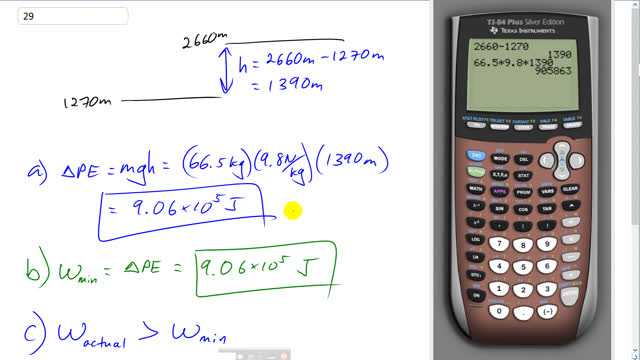
A 66.5-kg hiker starts at an elevation of 1270 m and climbs to the top of a peak 2660 m high.
- What is the hiker’s change in potential energy?
- What is the minimum work required of the hiker?
- Can the actual work done be greater than this? Explain.

In order to watch this solution you need to have a subscription.
This is Giancoli Answers with Mr. Dychko. The change in potential energy of this hiker equals mass times g times the change in height. So that's 66.5 kilograms times 9.8 newtons per kilogram times change in height of 1390 meters, when you take the height of the peak minus the starting height. And we get 9.06 times 10 to the 5 joules of potential energy. And the minimum work that the hiker will have to do is gonna be equal to that change in potential energy. It's the work, that the hiker does, which causes the change in potential energy. The hiker is what's providing the force that acts over some distance here, in order to make this change in potential energy possible. So it equals 9.06 times 10 to the 5 joules. And the actual amount of work that the hiker will do though will be greater than this minimum amount because the muscles are somewhat inefficient in their metabolism; muscles are producing heat, which is additional energy, being used up that's not actually going towards the mechanical energy of their change in height. And there's also going to be friction within the joints of the legs and so on. So the actual work will be more than that minimum value here.
Did a decimal place get lost in the answer for problem a? I believe that the answer is 9.06 x 10^5 for both a and b
Hi daniel, yes indeed, thank you for spotting that missing decimal. I have updated the quick answer.
Best wishes with your studies,
Mr. Dychko